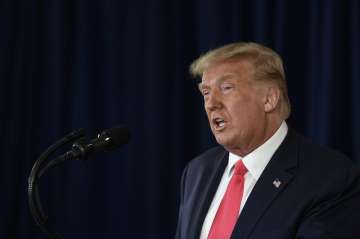Explained: What happens to chain of command when US President gets incapacitated
US President Donald Trump tested coronavirus positive on Friday amid the Presidential Election chaos. He was experiencing "mild symptoms," according to White House Chief of Staff Mark Meadows. However, his condition worsened by late Friday afternoon and he was transferred to Walter Reed National Military Medical Centre.

US President Donald Trump tested coronavirus positive on Friday amid the Presidential Election chaos. He was experiencing "mild symptoms," according to White House Chief of Staff Mark Meadows. However, his condition worsened by late Friday afternoon and he was transferred to Walter Reed National Military Medical Centre. Meanwhile, Democratic challenger Joe Biden took down his attack ads and pressed a bipartisan message in battleground Michigan after he and his wife tested negative.
Trump's health condition raises several questions about what will happen to his roles and responsibilities as a president if he gets too sick? However, the 25th Amendment of the US Constitution has a detailed process of the code of conduct to be followed in such instances.
In 1967, the 25th Amendment was ratified in the wake of President John F. Kennedy's assassination in 1963. The Amendment was intended to deal with any ambiguity about who leads the government when a president cannot.
What if the President becomes incapacitated? Here's how the things might work:
- The 25th Amendment would kick in if the President is unable to lead the country. It requires the president, if he determines that he is unable to discharge the duties of his office, to inform Congress, in writing, of his intent to voluntarily relieve himself of his duties. The vice president would then assume the duties of the presidency, as "acting president," until the time that the president informs Congress, again in writing, that he can resume his duties.
- According to Section 3, whenever the President transmits to the President pro tempore of the Senate and the Speaker of the House of Representatives his written declaration that he is unable to discharge the powers and duties of his office, and until he transmits to them a written declaration to the contrary, such powers and duties shall be discharged by the Vice President as Acting President.
- Section 4 which highlights the involuntary transfer of power allows the president to be challenged from resuming power if the vice president and principal officers of the president's Cabinet thought he was incapable of governing.
- In that unusual scenario, if the vice president and a majority of the "principal officers of the executive departments" were to make the determination that the president is unable to carry out the duties of his office, they would send a written declaration to Congress and install the vice president as acting president.
- However, if the president contests his removal, the vice president and a majority of the Cabinet must again declare in writing the president incapable of his duties within four days. Congress must then convene within 48 hours and has 21 days to decide the outcome. It would require a two-thirds vote of both chambers of Congress to declare the president unable to carry out his duties and remove him from office.
- If the vote fails to muster the required support, the president remains in office with all the powers and duties that entails.
What past instances show?
- The process of transferring power from a living president to vice president has come up only three times in history.
- Each time, the president gave up his duties voluntarily before planned surgeries that included sedation or anesthesia.
- President Ronald Reagan transferred power to Vice President George H.W. Bush in 1985 for about eight hours while he underwent surgery for colon cancer.
- Twice, in 2002 and 2007, President George W. Bush invoked Section 3 prior to going under anesthesia for routine colonoscopies, transferring presidential duties to Vice President Dick Cheney for roughly two hours each time.
- In contrast with Reagan, Bush specifically cited the 25th Amendment when declaring his disability and reclaiming his authority in his declaration to Congress.
Who will be the next president?
- In 1947, President Harry Truman signed the Presidential Succession Act, placing the majority leader of the House of Representatives ahead of the president pro tempore of the Senate in the line of succession behind the vice president.
- So, if both Trump and Pence were unable to perform the duties of the president, there would be a written declaration, and House Speaker Nancy Pelosi would be required to resign both as a speaker and as a representative in Congress in order to become acting president. President pro tempore of the Senate Sen. Chuck Grassley, R-Iowa, would be next in line after Pelosi.
While Biden vowed to continue his cautious approach to campaigning during the pandemic, the president’s diagnosis injected even greater uncertainty into an election already plagued by crises that have exploded under Trump’s watch: the pandemic, devastating economic fallout, and sweeping civil unrest. With millions of Americans already voting, the country on Friday entered uncharted territory that threatened to rattle global markets and political debates around the world.
(With inputs from ABC and Associated Press)